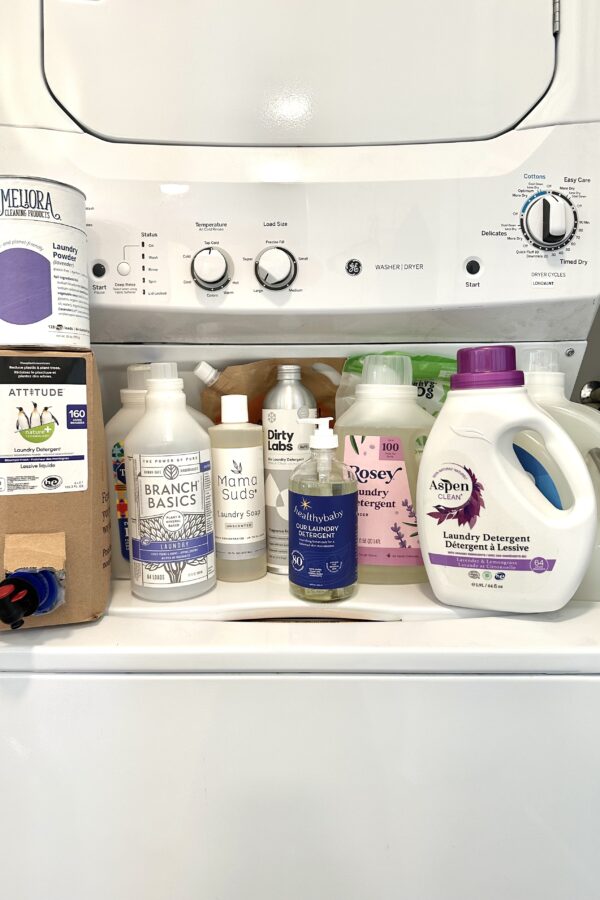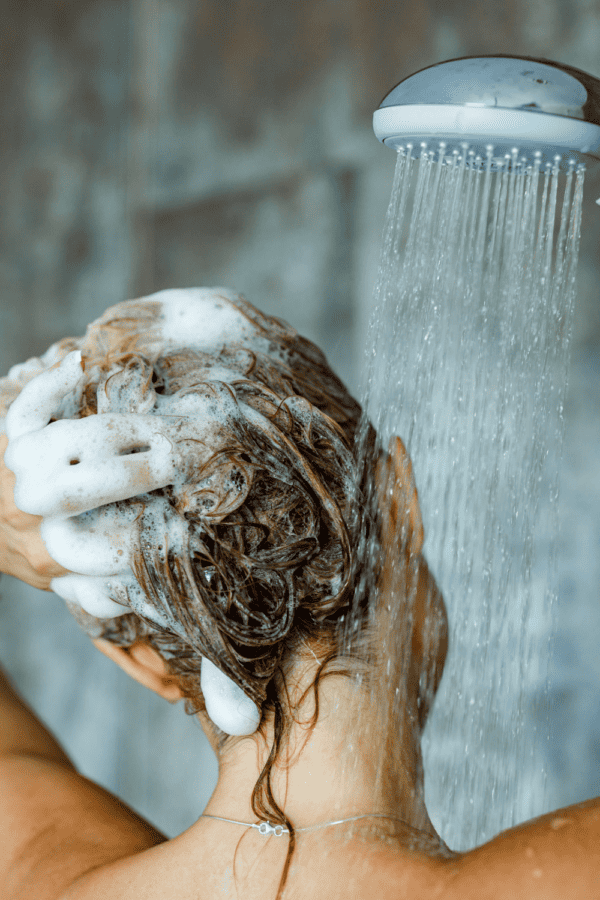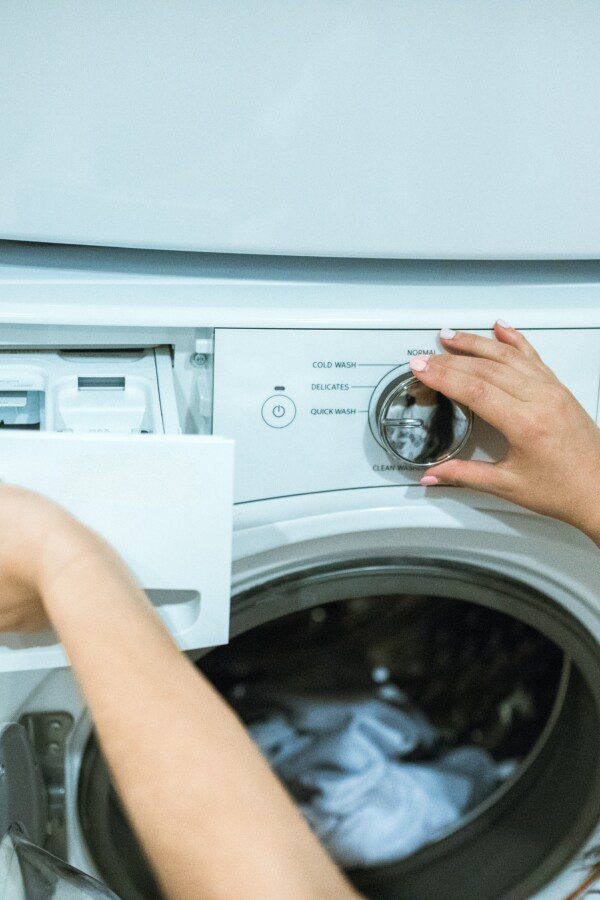If you start looking at the ingredient labels on your personal care and cleaning products, you’ll probably notice that there is one common ingredient in almost ALL of them: “fragrance.”
If you care about actually knowing what’s in the products you buy and use, this word “fragrance” (also sometimes listed as “parfum,” “perfume,” “eau de toilette,” or “aroma”) presents a huge problem for you because it’s not actually an ingredient! Rather, it’s an umbrella term that allows manufacturers to legally hide nearly 4,000 different chemicals in their products!
As you may have already experienced, navigating natural and synthetic fragrances can be quite difficult for consumers due to this weird fragrance loophole. So, this article will hopefully help you understand:
- How the fragrance loophole works in consumer products
- What the word “fragrance” on ingredient labels actually means
- The difference between natural and synthetic fragrance
- Whether or not natural and synthetic scents are “bad” or toxic
- The various types of toxic chemicals that can hide under the word word “fragrance”
- How to identify and avoid these toxicants
Table of Contents
- What Does the “Fragrance” Label Actually Mean?
- What Is “Natural Fragrance”?
- Potential Downsides to Natural Fragrance Oils
- Potential Downsides to Essential Oil Fragrances
- The Toxic Chemicals Hidden in “Fragrance”
- Phthalates
- Other Endocrine Disruptors
- Carcinogens
- Volatile Organic Compounds (VOCs)
- Allergens & Irritants
- Sooo… Should I Go For “Fragrance-Free” and “Unscented” Products?
- Being Mindful of People with Fragrance Sensitivity and Multiple Chemical Sensitivity
- Recent Updates to Fragrance Transparency Laws
- Can People Tell Artificial Smells From Real Ones?
- It’s Not Just Perfume. Here Are Common Places Where You’ll Find the “Fragrance” Label
- How To Identify Safer Fragrance Products
- More Tips for Avoiding Dangerous Synthetic Scents
- Wrapping Up: The “Fragrance Loophole” in a Nutshell
What Does the “Fragrance” Label Actually Mean?
Because of the Federal Fair Packaging and Labeling Act of 1973, companies are required to list a product’s ingredients on the label… EXCEPT when it comes to fragrance.
In the United States, fragrance secrecy is legal due to what is sometimes called the “fragrance loophole.” Because fragrance formulations have been determined to be “trade secrets,” companies can put a number of almost 4,000 different chemicals in their product under the umbrella term, “fragrance.”
The International Fragrance Association (IFRA) is the self-regulating organization that sets the standards for the industry. They decide what chemicals are allowed under the fragrance loophole, and which ones are not.
(Some chemicals are prohibited or restricted; however, as of spring 2023, IFRA has banned only 86 chemicals.)
The list of chemicals that are allowed under the “fragrance” label is constantly growing; as of 2022/23, the list includes 3,619 different chemicals.
3,224 of those ingredients are actually used for scent (“odor or malodor coverage”), and 395 of the chemicals are “functional ingredients,” which are “used to support the functionality and/or durability of a fragrance compound.” This can include solvents, stabilizers, masking agents, UV-absorbers, propellants, viscosity controllers, preservatives, and dyes.
Many of those chemicals are safe and harmless, while others pose established threats to human and environmental health (we’ll get to that in a minute).
This lack of transparency—and the fact that consumers have absolutely no way of knowing whether or not the “fragrance” in their products is dangerous or not—is one of the main reasons why many low-tox lifestyle advocates recommend avoiding fragranced products when possible.
The use of synthetic fragrance is very widespread; it applies to everything from skincare and cosmetics, to personal care, candles, cleaning products, and more.
We’re going to go into more detail about the most dangerous chemicals that are allowed in scented products in just a moment, but first let’s address another question you might have about fragrances: are natural fragrances better?
What Is “Natural Fragrance”?
Before we talk more about the potentially toxic chemicals that can hide under the “fragrance” umbrella, it might be helpful to differentiate between ‘synthetic fragrance oils,’ ‘natural fragrance oils,’ and ‘essential oils.’ After all, both ‘natural’ and ‘synthetic’ ingredients can be included under the “fragrance” umbrella.
First, let’s clarify something: “natural” does not automatically mean “better” or “safer,” and “synthetic” does not automatically mean “bad” or dangerous.”
In general, ingredients and materials that come directly from nature tend to be safer than many petroleum-derived synthetics, but it ultimately just comes down to the specific ingredient we’re talking about.
Lead, for example, is a naturally-occurring substance that is extremely toxic to humans, especially little ones. On the other hand, dl-alpha-tocopherol, or synthetic vitamin E, is a safe synthetic ingredient that’s commonly used in cosmetics.
So what does it mean when you see “natural fragrance” on an ingredient label?
Natural Fragrance Oils vs. Essential Oils
Natural fragrance oils and essential oils are not the same thing (although companies will often include essential oils under a ‘natural oils’ umbrella in their marketing).
The main difference between the two has to do with the manufacturing process.
Essential oils are directly extracted from plants through methods like steam distillation or cold pressing, and contain the pure essence of the plant, with no additives.
On the other hand, natural fragrance oils (which are sometimes called “plant-based fragrance oils”) are typically man-made, and are composed of natural aromatics like essential oils and absolutes. They are often combined in a carrier oil, and may contain synthetic elements to enhance the scent.
Potential Downsides to Natural Fragrance Oils
It’s important to note that there is very little regulation or accountability with regard to how this term is used. Some fragranced products “made with natural oils” may still contain synthetic materials, including toxic ones. (So don’t hesitate to reach out to the brand you’re shopping from to ask for more details if you need to.)
For example, 2007 testing by the NRDC found 0.25 ppm of DBP in an a Citrus Magic air freshener marketed as “all natural.” Sure, that’s not very much, but it’s definitely not “all-natural” and it’s not “phthalate-free.”
Additionally, many “natural” fragrance ingredients are isolates, which means they’ve been extracted from the whole plant compound. Several of these isolates have been classified by the E.U. as allergens and sensitizers, meaning you can develop an allergy to them after using them repeatedly.
The E.U.’s list includes 26 different chemicals, including:
- Citral
- Linalool
- Limonene
- Coumarin
- Citronellol
- Benzyl cinnamate
- Citronellol
- and others
These ingredients won’t cause a problem for a lot of people. But those who have sensitive skin or are more prone to allergies or asthma will probably want to watch out for these ingredients.
Potential Downsides to Essential Oil Fragrances
Now, essential oils are generally safe when they’re used properly, but they aren’t always perfect either. There are a few things to be aware of when it comes to using essential oils in fragrance products:
- Essential oils are highly concentrated, which is very different from how the plants and herbs are actually found in nature. Even though a certain plant may be completely safe, ingesting the incredibly concentrated essential oils could be dangerous. Eucalyptus, for example, is used in personal care products as a fragrance and skin conditioning agent, but actually drinking a bottle of eucalyptus essential oil can potentially cause seizures.
- Anyone can be allergic to anything, and some individuals can have allergic reactions to plant-based or essential oils. For example, those who are allergic to ragweed should avoid using chamomile.
- Unfortunately, the Food and Drug Administration (FDA) does not regulate the essential oil industry, which makes careful sourcing important for both brands and consumers. Companies that use essential oils to scent their products should make sure they’re buying from a trusted supplier whose oils don’t contain additives, fillers, or synthetics.
- Essential oils can also be sourced in an unsustainable way, so it’s important that companies are conscious about how they obtain their natural scents from an environmental standpoint as well.
Most of the concern with essential oils comes from improper use (for example, ingesting them when they should be diffused or only used topically, or not diluting them when they should be diluted).
This usually isn’t an issue when we’re talking about natural fragrances, since (most!) manufacturers work with formulators who know the safe, proper amounts of of oils to put in their products. Katie Wells from Wellness Mama has a great guide to safe essential oil use here.
When sourced responsibly and used correctly, botanicals and essential oils can be a great safe way to add pleasant aromas to perfumes, cosmetics, personal care products, cleaning supplies, and more.
Additionally, many brands that exclusively use plant/essential oils for their fragrance tend to actually list them on their ingredient list, giving more transparency to consumers. (Although, this isn’t always the case. Plant-based and essential oils can still be covered under the “fragrance” loophole.)
That said, consumers should also be aware that products often contain both natural and synthetic fragrances. Sometimes brands can use this as an opportunity to greenwash you.
For example, I’ve seen products that say “Made with essential oils” on the front of the bottle, leading potential customers to think the product is scented only with essential oils and is therefore “safe” and “natural.” The reality, however, is that the product also includes synthetic and undisclosed “fragrance” ingredients in addition to a few essential oils.
Home
Why is Ingredient Transparency So Important, Anyway?
We’ve recently seen increased demand from consumers & activists to improve labeling requirements on consumer goods. But WHY does ingredient transparency matter?
The Toxic Chemicals Hidden in “Fragrance”
Now let’s talk about synthetic fragrance. Synthetic ingredients can include an artificial version of a real, naturally-occurring chemical (for example, you can make synthetic lavender oil, vitamin E, or beeswax), and synthetic ingredients can also include man-made chemicals invented by scientists and not found in nature.
As explained above, not all of the synthetic scents on IFRA’s list are bad, but many of them are. Very concerning is the fact that A LOT of them haven’t even been tested for safety, with new ones being developed all the time.
IFRA states that “Manufacturers are responsible for the safety of the ingredients they use in their products,” however, no one is even holding them accountable for doing so. The FDA cannot require manufacturers to test cosmetic products and their ingredients for safety.
Even though there is a lot of missing information about the safety of this long list of chemicals, we do know that many of them pose a threat to human health. So we’re going to go through some of the potentially toxic synthetic fragrance chemicals that are commonly used in the products consumers use every day so that you can be more aware of what is actually in your fragrance products.
Phthalates
Why phthalates are bad: You’ve probably heard of phthalates before, as their dangers have been making more headlines over the past decade.
It seems like the more research that’s done on phthalates, the worse they get. Phthalates are known endocrine disruptors, which means they can mess with your body’s natural hormone function. Phthalates have been linked to a whole host of problems, such as:
- early onset of puberty
- reproductive and genital defects
- lower testosterone and lower sperm count in males (decreased fertility)
- autism
- chronic inflammation
- cardiovascular disease
- type-2-diabetes
- cancer
- obesity
- asthma
It’s no wonder that a 2021 study found that “people with the highest levels of phthalates had a greater risk of death from any cause.“
But the problem with this group of chemicals isn’t JUST that they have the potential to cause or exacerbate all of these different health concerns, it’s also that they are everywhere.
They’re not just in your fragrances and personal care products; they’re also in food packaging, toys, flooring, and all kinds of plastic and PVC products. This is why it can be beneficial to try and avoid them when you actually can, in part by choosing safer skincare and cleaning products.
Examples of phthalates allowed under the fragrance loophole: Bis(2-ethylhexyl) terephthalate, Di(2-ethylhexyl) phthalate, Dibutyl phthalate, Diethyl phthalate, Dimethyl phthalate, Dioctyl phthalate
Why phthalates are used in fragrance: Phthalates are commonly used (and hidden) in fragrances, and most of the time it’s to make the scents last longer.
[Note that although IFRA calls it their “Transparency List,” phthalates are actually not listed in their glossary. That’s because they’re not actually used to scent the product, but rather as “functional” ingredients. Their “transparent” Fragrance Ingredient Glossary (FIG) “covers all materials on the IFRA Transparency List (other than functional ingredients not used for odor-giving properties).”]
Other Endocrine Disruptors
Why endocrine disruptors are bad: There are also other endocrine disruptors that aren’t phthalates. These chemicals can disrupt healthy hormone function and cause a snowball of negative health effects in a similar way that phthalates can.
Examples of other endocrine disruptors allowed under the fragrance loophole: ethylene brassylate, benzophenone, butylated hydroxyanisole (BHA), musk ketone, resorcinol
Why these endocrine disruptors are used in fragrance: While some of these are used for scent, many of these chemicals are often used as “masking agents” to neutralize the smells of other ingredients. Masking agents are especially sneaky because they can even show up in products marketed as “unscented.”
Carcinogens
Why carcinogens are bad: They can cause cancer.
Examples of carcinogens allowed under the fragrance loophole: naphthalene, styrene, formaldehyde and other aldehydes, benzene, acetaldehyde, butylated hydroxyanisole
Why carcinogens are used in fragrance: These chemicals are added for a number of different reasons, including as preservatives, masking agents, and general “perfuming.”
Volatile Organic Compounds (VOCs)
Why VOCs are bad: Even though not all VOCs are bad, people are usually talking about the potentially toxic ones when they use the term VOCs.
VOCs are chemicals that can vaporize under normal atmospheric conditions (like in your home) and contribute to indoor air pollution. When people talk about their furniture and other goods “off-gassing,” they’re talking about VOCs leaking out of their products and into the air in their house. Toxic VOCs are linked to various acute and chronic health concerns, such as:
- Eye, nose, & throat irritation
- Headaches
- Nausea/vomiting
- Dizziness
- Worsening of asthma symptoms
- Cancer
- Liver & kidney damage
- Central nervous system damage
You can read more about VOCs here.
Examples of VOCs allowed under the fragrance loophole: acetone, butane derivatives, disulfides, ethanols, isopropyl alcohol, propane derivatives
Why VOCs are used in fragrance: In fragrance products, VOCs are used as solvents, drying agents, propellants, viscosity controllers, and more.
Allergens & Irritants
Why allergens and irritants are bad: This is more of a gray area because technically anything can be an allergen or irritant for someone. Most people have no problem with pineapples, for example, but there is a small percentage of people who are allergic and will have a negative reaction to them.
So while anything can technically be an allergen, there are some things that irritate a larger number of people, and these are the ingredients we look out for in our personal care and cleaning products. These chemicals are more likely to cause things like:
- headaches
- migraines
- difficulty breathing
- sneezing
- coughing
- contact dermatitis
- asthma
Some of these ingredients can exacerbate or trigger pre-existing allergies, respiratory problems, or skin conditions, while other ingredients can actually cause those symptoms. These chemicals are called sensitizers and I talked about them above.
Whether or not someone reacts to a specific chemical (or mix of chemicals) depends on various factors such as the vulnerability of the individual, the ingredient dosage, and more.
Examples of allergens and irritants allowed under the fragrance loophole: benzyl salicylate, benzyl benzoate, resorcinol, limonene, linalool
Why allergens and irritants are used in fragrance: These chemicals are used as denaturants, masking agents, scents, and more.
Sooo… Should I Go For “Fragrance-Free” and “Unscented” Products?
You might think that buying products labeled “fragrance-free” or “unscented” is a better option, and many times, it is! However, products don’t actually have to lack these fragrance chemicals in order to be labeled as “fragrance free” or “unscented.”
In fact, many products will actually contain “masking agents” (many of which are on IFRA’s fragrance list and mentioned above) in order to prevent your brain from perceiving odors from the various other chemicals.
So if you’re reaching for the fragrance free or unscented products, just make sure you check the label carefully before buying!
Being Mindful of People with Fragrance Sensitivity and Multiple Chemical Sensitivity
A large number of people are sensitive to fragrances in a more general or unspecific way. Most studies have shown that around 30% of adults have a “fragrance sensitivity,” where they experience some sort of acute adverse reaction to fragrances, including migraines, asthma attacks, or skin reactions.
These studies have not focused on any specific chemical (or group of chemicals) in fragrance, but rather focus on scented products more generally. So you can’t necessarily point to one specific chemical that’s causing the problem here.
Additionally, those with Multiple Chemical Sensitivity (MCS) may react to any scents (even “safe” or weak ones) due to what is suspected by some doctors to be a potential limbic system disorder. This is an area that not very well understood and absolutely deserves more research.
It’s worth keeping this in mind as you decide whether or not to use or wear fragranced products in public places, such as your workplace.
Recent Updates to Fragrance Transparency Laws
There has recently been a little bit of progress made when it comes to fragrance ingredient transparency in the U.S.
In late 2022, President Biden signed into law the Omnibus Spending bill, which included the Modernization of Cosmetics Regulation Act of 2022 (MOCRA). This is the first time federal cosmetics law has been updated since 1938!
Among other things, this bill requires labeling of fragrance allergens. Although the specifics of what the FDA constitutes as an “allergen” have not been released, it will likely be similar to to the E.U.’s list of 26 ingredients, explained above.
It also requires mandatory reporting of serious adverse health events caused by cosmetic products and gives the FDA more power to request product safety information if there are concerns about a product being misbranded.
Here’s a good summary of MOCRA.
There’s also a California law (SB 312) that passed in 2020 (and went into effect in 2022), which requires cosmetics and salon product companies in California to report the presence of any fragrance or flavor ingredient that appears on one or more of the 23 authoritative hazard lists.
Those reports are then made public through a database.
So for example, since DEHP is on the Prop65 list, a company is required to report that. You can see this is the case for a Bon Parfumeur Jasmine Hibiscus perfume.
(It’s unclear at this time if and/or how this law is currently being enforced. It seems to me to be based on the honor system at this time.)
Although MOCRA and SB 312 do not get rid of the fragrance loophole, they are at least a step in the right direction.
Can People Tell Artificial Smells From Real Ones?
Some people, especially those who are extra sensitive to chemicals, can usually tell when there are a lot of strong, synthetic chemicals and fragrances in a product. Naturally-scented products tend to be softer and less harsh on the senses.
But sometimes synthetic fragrances can also be soft as well, or even not noticeable at all (like we just discussed with “unscented” products). So in general, you shouldn’t rely on your nose to tell you whether or not your products contain natural or artificial smells.
It’s Not Just Perfume. Here Are Common Places Where You’ll Find the “Fragrance” Label
When people think “fragrance,” perfume or cologne is often the first thing that comes to mind. But there are TONS of products that contain these chemicals. Here are the common ones:
- Shampoo, conditioner, and other haircare products
- Body wash, hand soap, face soap, and other cleansers)
- Baby lotions, shampoos, and other baby products
- Lotions and moisturizers (find safe brands here)
- Makeup & cosmetics (safer alternatives here, here, and here)
- Deodorant (click here for the good brands)
- Shaving cream
- Sunscreen
- Nail polish and nail polish remover
- Pads, tampons, and other feminine care products
- Candles
- Air fresheners (here are our recommended brands)
- Laundry and dish detergent
- Fabric softener, scent beads, and other laundry products
- Cleaning products (all-purpose cleaner, wipes, toilet bowl cleaner, sanitizer, etc.)
- Paper products like tissues, paper towels, and toilet paper
- Even things like clothing and packaging can technically contain “fragrance,” although it’s less common
How To Identify Safer Fragrance Products
- Look for brands that actually list the specific chemicals used in their fragrance, either right on the product label or at the very least, on their website.
- Don’t be afraid to reach out and ask brands for more information. The more transparent, the better. If they’re unwilling to tell you because it’s “proprietary information” or they’re trying to avoid actually answering your questions, move on.
- Look for products that have been verified to be free of toxic chemicals by a third-party organization like MADE SAFE or EWG.
- Look for certified organic products.
More Tips for Avoiding Dangerous Synthetic Scents
- Instead of just covering up scents with sprays and detergents, keep things fresh and clean by opening up the windows, getting an air purifier, and cleaning with vinegar.
- Consider using fresh flowers and houseplants to keep your home environment smelling and feeling fresh.
- Learn how to live with less fragrances. Some people really love that strong scent they get after cleaning the house or taking a load of laundry out of the wash… But you may want to consider taking a couple of months off from those strong synthetic scents and just see what it’s like! Try slowly making the switch to D.I.Y. or non-toxic products.
- Talk to your manager or HR professional about removing things like plug-in air fresheners from the workplace and ask if they will consider implementing a fragrance-free workplace policy, which has become more common.
- Support legislation and non-profit organizations that advocate for safer personal care and cleaning products. A few are Women’s Voices for the Earth, Breast Cancer Prevention Partners, and Toxic Free Future.
- And of course, use The Filtery’s guides to shop from brands that have already been vetted to be free of toxic chemicals!
Wrapping Up: The “Fragrance Loophole” in a Nutshell
This is a complicated issue, but in short, there are three main problems when it comes to fragranced products:
Problem #1: There are a lot of hidden ingredients and a huge lack of transparency for consumers due to the “fragrance loophole,” which legally allows companies to NOT disclose the ingredients they use in their scented products.
Problem #2: Many of the those hidden ingredients are known to be toxic and have the ability to cause and/or exacerbate a wide range of health concerns, from infertility to cancer and more.
Problem #3: Synthetic fragrances are ubiquitous; they’re everywhere! In fact, according to the Campaign for Safe Cosmetics, “more than 95 percent of shampoos, conditioners, and styling products contain fragrance”! This means most of us are being exposed to these toxic chemicals all day, every day.





